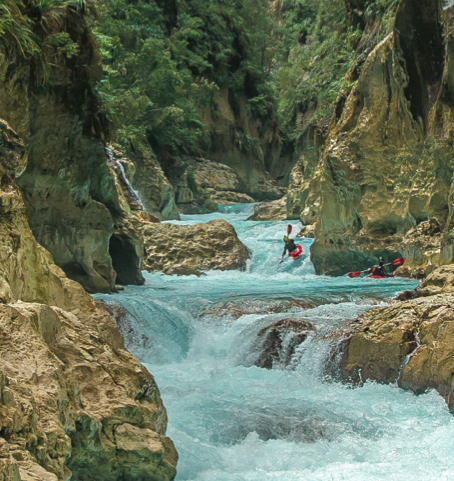Hair-raising, epic first descent by kayakers of the Beriman River in East New Britain, reported by Richard Andrews
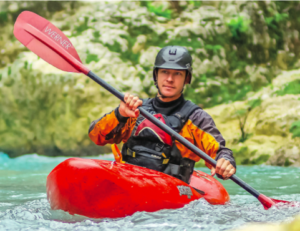 One slip and it’s over when you’re climbing the wall of a steep gorge with 50 kilograms of loaded kayak dangling by a rope from your waist. That was just one of the risks faced earlier this year by four adventurers tackling the first descent of New Britain’s spectacular Beriman River.
One slip and it’s over when you’re climbing the wall of a steep gorge with 50 kilograms of loaded kayak dangling by a rope from your waist. That was just one of the risks faced earlier this year by four adventurers tackling the first descent of New Britain’s spectacular Beriman River.
Californian Ben Stookesberry, fellow American Chris Korbulic, Canadian Ben Marr and Brazilian Pedro Oliva, spent two weeks paddling one of the South Pacific’s most challenging river canyons – a remote, 50-kilometre stretch of turbulent water and narrow channels contained by walls reaching 1200 metres.
“Some parts of the river are not navigable or are partly underground,” says Stookesberry. “Portaging around them meant having to use bolts and climbing ropes to haul ourselves and the kayaks up the canyon walls. “Then we had to hack our way through the jungle using machetes, and figure out how to get back down to the river past the obstacles.”
 As one of National Geographic’s adventurers of the year, Stookesberry’s addiction to exploratory kayaking started when he broke his femur while mountain biking. “Healing the injury took 12 months, but during that time I was still able to get into a boat, and I fell in love with kayaking,” he says. “Since then, I’ve taken on 70 first descents in 15 countries, but the Beriman was one of the most intense epics. And that’s saying something!”
As one of National Geographic’s adventurers of the year, Stookesberry’s addiction to exploratory kayaking started when he broke his femur while mountain biking. “Healing the injury took 12 months, but during that time I was still able to get into a boat, and I fell in love with kayaking,” he says. “Since then, I’ve taken on 70 first descents in 15 countries, but the Beriman was one of the most intense epics. And that’s saying something!”
Stookesberry, Korbulic and Oliva have been dubbed ‘Kayaking’s Most Extreme Trio’ for running some of the world’s most inaccessible rivers, from Bhutan and Brazil to Greenland and Africa. However, the Beriman elicited a few gulps when they first scouted the river for a week with the rest of the team. It became apparent that the descent would involve a combination of climbing, canyoneering and kayaking in areas where rescue might not be possible if something went wrong.
“There’s actually 13 gorges inside this massive canyon, with no roads, trails or villages anywhere near the headwaters, where we had to get dropped off by helicopter,” says Stookesberry.
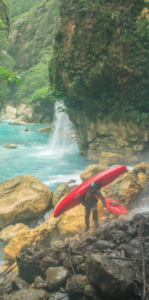 “On day one, the
area was shrouded in mist and we didn’t know if we could proceed. Luckily we made it, because PNG has some of the most experienced and savvy pilots in the world. The whole expedition would have been impossible without their support, and I can’t say enough about them.”
“On day one, the
area was shrouded in mist and we didn’t know if we could proceed. Luckily we made it, because PNG has some of the most experienced and savvy pilots in the world. The whole expedition would have been impossible without their support, and I can’t say enough about them.”
Once started, the team had to manoeuvre its 2.5-metre kayaks around treacherous rocks, difficult rapids and turbulence.
“It was terrifying at times,” admits Stookesberry. “I recall one day when we were all clinging to a nasty little eddy in class V whitewater with no way out of the river and another terrifying bend just downstream.”
In addition, rain fell every day of the expedition, creating another concern: flash flooding.
“Fortunately the river stayed low enough for us not to get caught by rising waters, which could have been be lethal if we were hemmed in by overhanging limestone walls or camping just above the river,” says Stookesberry.
“But even though we were scared and stressed out, none of us could get over the crazy beauty of the place,” he wrote in his journal.
“These massive limestone walls, decorated with travertine sculptures, like stalactites that fluted together into something like a thousand-foot-tall Christmas tree. There were waterfalls that fire-hosed turquoise water into the river from dozens of still-unknown caves.
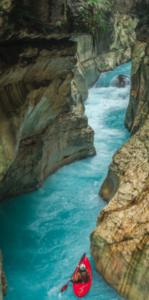 “More than a few times, giant fruit bats with six-foot wingspans flooded the narrow strip of sky overhead, seemingly out of nowhere. Pedro kept comparing it to the movie Avatar, but somehow that fiction didn’t seem to do this place justice.”
“More than a few times, giant fruit bats with six-foot wingspans flooded the narrow strip of sky overhead, seemingly out of nowhere. Pedro kept comparing it to the movie Avatar, but somehow that fiction didn’t seem to do this place justice.”
Stookesberry credits fishing-lodge owner Riccard Reimann for the team’s success. “Riccard helped with scouting and extra equipment, but more importantly talked to the villagers about the trip. We wanted to establish good rapport with locals rather than showing up out of nowhere. He saw our visit as good promotion for ecotourism on the island.”
In fact, the Beriman will get international exposure in an upcoming documentary about the expedition by Canadian filmmaker Bryan Smith. “I followed the team from the air and the river bank,” he says. “We anticipated tension and drama, but I have to admit there were moments when I wondered if they’d get out of there.”
Stookesberry himself is looking forward to his next PNG trip with the same crew. “Apart from some foot rot from the constant damp, we came out of the Beriman unscathed, and now I want to explore rivers in the Central Highlands,” he says.
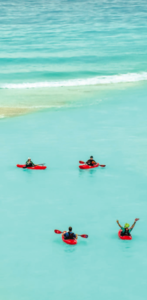 “Along with the Himalayas and the Arctic, PNG is one of the frontiers of expedition kayaking, and I think another adventure is in order.”
“Along with the Himalayas and the Arctic, PNG is one of the frontiers of expedition kayaking, and I think another adventure is in order.”
FOOTNOTE: The expedition was staged from Liamo Reef Resort at Kimbe before the team moved to the Delawin Guest House on the remote south coast in the Pomio District. Ben Stookesberry says: “Both are places that I would highly recommend, not only for the accommodation but also for the local expertise and advice provided by their principals – Riccard Reimann at Liamo and Iggie Matapia at Delawin”.
Paradise Magazine, November/December 2015

